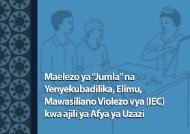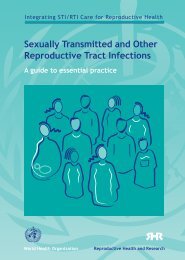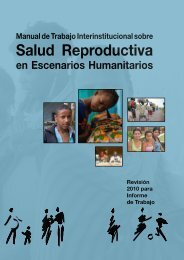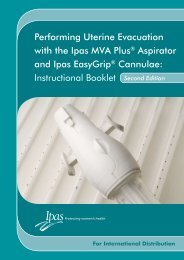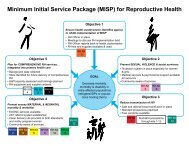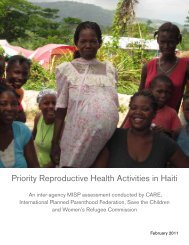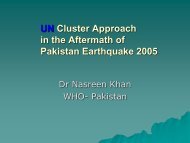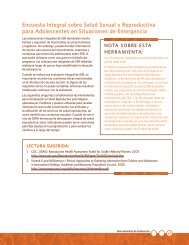Sexual and Reproductive health needs assessment of ... - IAWG
Sexual and Reproductive health needs assessment of ... - IAWG
Sexual and Reproductive health needs assessment of ... - IAWG
You also want an ePaper? Increase the reach of your titles
YUMPU automatically turns print PDFs into web optimized ePapers that Google loves.
<strong>Sexual</strong> <strong>and</strong> <strong>Reproductive</strong><strong>health</strong> <strong>needs</strong> <strong>assessment</strong> <strong>of</strong>Mobile <strong>and</strong> vulnerablecommunities in ZimbabweDr.Sathyanarayanan DoraiswamyUNFPA, Zimbabwe
Background• Zimbabwe- a complex emergency• Major waves <strong>of</strong> displacementa) Fast track l<strong>and</strong> reform (2002)- 160,000b) Operation Murambatsvina (2005)-700,000• IOM Zimbabwe responds to community <strong>health</strong> <strong>needs</strong> <strong>of</strong> MVPs(IDPs) <strong>and</strong> UNFPA provides support on SRH issues• Few studies have established SRH <strong>needs</strong> <strong>of</strong> MVPs
Objectives• To assess the sexual <strong>and</strong> reproductive <strong>health</strong> (SRH)<strong>needs</strong> <strong>of</strong> mobile <strong>and</strong> vulnerable populations (MVPs) inZimbabwe• To assess knowledge, attitude <strong>and</strong> practices amongMVPs with regard to SRH <strong>and</strong> to assess the barriers tosexual <strong>and</strong> reproductive <strong>health</strong> services in thecommunities• To assess the degree to which current <strong>health</strong> servicesmeet SRH <strong>needs</strong> <strong>of</strong> MVPs (availability <strong>and</strong> accessibility<strong>of</strong> SRH services)
Methodology• Quantitative study (Stratifiedcluster sample) design• 62/116 communities in 22 districts• 1900/ 28690 women (15-49)• Tools referenced:IOM Zimbabwe-2007RH <strong>assessment</strong> in conflict affectedwomen- CDC toolkitInter-Agency Global Evaluation <strong>of</strong> RHServices for Refugees <strong>and</strong> IDPsRefugee reproductive <strong>health</strong> <strong>needs</strong><strong>assessment</strong> (RHR consortium)
Findings-1Thematic area Key indicator/s ProportionSafe MotherhoodFamily planning<strong>Sexual</strong> history,practices& STIsANCHome deliveryStill birthBleeding as a danger signUnwanted pregnancyAttempted terminationMedian age- sexual debutCondom use in last sexPrevalence <strong>of</strong> genitalulcers/ dischargeTransaction sex(‘widespread’- perception)50%35%10%11%49%46% <strong>of</strong> above17 (18.7-National)21%20% (35% sought notreatment)78%
Findings-2ThematicareaKey indicator/sProportionHIVSGBVHealthfacilitiesUsing condoms as a method <strong>of</strong>HIV prevention-KnowledgeTesting (ever)Prevalence <strong>of</strong> forced sexHave not sought any serviceAccess to Hygiene suppliesQualitative (observation)80.5% (75.7% National)38.7%(7% National)25%45.7%40% had no access60% >15 kmsBEMONC services notuniformly availableSerious shortage <strong>of</strong> staff,drugs <strong>and</strong> supplies
Challenges/ Limitations• Access challenges: a) Politically sensitive population in acharged environment b) Difficult terrain <strong>and</strong> resourcelimitations- Not all communities studied• Qualitative studies (Men <strong>and</strong> young people) could not becarried out• Host populations not studied; relative vulnerability notknown• Health facilities- observation only <strong>and</strong> hence difficult tovalidate
Conclusion/ Recommendation• Knowledge gaps <strong>of</strong> MVPs in SRH need to be addressedwith a focused IEC/BCC campaign.• Barriers to access: Safe motherhood, FP <strong>and</strong> GBVservices <strong>of</strong> the MVP communities need to be urgentlyaddressed by a joint SRH programme for MVPs.• Health facilities in the areas surrounding MVPcommunities need immediate support (staffing <strong>and</strong>supplies)
Lessons learnt• SRH <strong>needs</strong> <strong>assessment</strong> in populations <strong>of</strong> humanitarianconcern helps identify key programmatic priorities• Joint <strong>assessment</strong> provides a good opportunity for furtherstrengthening partnership during planning,implementation, monitoring <strong>and</strong> evaluation <strong>of</strong> theprogramme• A complex emergency imposed on a weakening <strong>health</strong>care system pose programmatic challenges to agencies
Thank You




